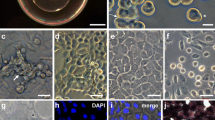Summary
The zebrafish is increasingly popular as a nonmammalian model for studies of vertebrate developmental biology, genetics, and toxicology. The availability of cell culture systems makes it possible to address many basic questions using in vitro approaches. Here we describe materials and procedures for initiating cell cultures from zebrafish early (blastula- and gastrula-stage) diploid and haploid embryos and adult tissues (gills, fins, liver, viscera). Zebrafish cells are grown in a complex basal nutrient medium supplemented with insulin, selenite, fetal bovine serum, trout serum, and an extract prepared from rainbow trout embryos. The procedure for preparing trout embryo extract (demonstrated to be mitogenic for a variety of piscine cell lines), is also described.
Similar content being viewed by others
References
Bayer TA, Campos-Ortega JA (1992). A transgene containinglacZ is expressed in primary sensory neurons in zebrafish. Development 115: 421–426.
Bradford CS, Sun L, Collodi P, Barnes DW (1994). Basic FGF stimulates proliferation and suppresses melanogenesis in cell cultures derived from early zebrafish embryos. Mol Mar Biol Biotechnol 3: 78–86.
Bols NC, Lee LEJ (1991). Technology and uses of cell cultures from the tissues and organs of bony fish. Cytotechnology 6: 163–187.
Collodi P, Barnes DW (1990). Mitogenic activity from trout embryos. Proc Natl Acad Sci USA 87: 3498–3502.
Collodi P, Kamei Y, Ernst T, Miranda C, Buhler DR, Barnes DW (1992). Culture of cells from zebrafish (Brachidanio rerio) embryo and adult tissue. Cell Biol Toxicol 8: 43–61.
Collodi P, Kamei Y, Sharps A, Weber D, Barnes D (1992). Fish embryo cell cultures for derivation of stem cells and transgenic chimeras. Mol Mar Biol Biotechnol 1: 257–265.
Culp P, Nüsslein-Volhard C, Hopkins N (1991). Highfrequency germ-line transmission of plasmid DNA sequences injected into zebrafish eggs. Proc Natl Acad Sci USA 88: 7953–7957.
Driever W, Rangini Z (1993). Characterization of a cell line derived from zebrafishBrachidanio rerio. In Vitro Cell Dev Biol 29A: 749–754.
Eaton RC, Farley RD (1974). Spawning cycle and egg production of zebrafish,Brachidanio rerio, in the laboratory. Copeia 1974: 195–209.
Ghosh C, Collodi P (1994). Culture of cells from zebrafish (Brachidanio rerio) blastula-stage embryos. Cytotechnology 14: 21–26.
Hightower LE, Renfro JL (1988). Recent applications of fish cell culture to biomedical research. J Exp Zool 248: 290–302.
Hisaoka KK, Battle HI (1998). The normal developmental stages of the zebrafish,Brachidanio rerio (Hamilton-Buchanan). J Morphol 102: 311–328.
Ho RK, Kimmel CB (1993). Commitment of cell fate in the early zebrafish embryo. Science 261: 109–111.
Laale HW (1977). The biology and use of zebrafish,Brachidanio rerio in fisheries research: A literature review. J Fish Biol 10: 121–173.
Laale, HW (1977). culture and preliminary observations of follicular isolates from adult zebra fish,Brachidanio rerio. Can J Zool 55: 304–309.
Laale HW (1981). Fish embryo culture: Migration and spreading of zebrafish (Brachidanio rerio) pigmented retinal epithelium. In Vitro 17: 701–705.
Laale HW (1981). In vitro primary spreading and dissociation of zebrafish,Brachidanio rerio, blastoderm-derived embryonic epidermis. Can J Zool 59: 800–811.
Laale HW (1981). In vitro secondary spreading from dissociating blastoderm-derived embryonic tissues of the zebrafish,Brachidanio rerio. Can J Zool 59: 812–822.
Lannan CN, Winton JR, Fryer JL (1984). Fish cell lines: establishment and characterization of nine cell lines from salmonids. In Vitro 20: 671–676.
Nicholson BL (1988). Fish cell culture: an update. Adv Cell Cult 7: 1–18.
Rachlin JW, Perlmutter A, Seeley RJ (1967). Monolayer culture of gonadal tissue of the zebra danio,Brachidanio rerio. Prog Fish Cult 28: 232–234.
Rinder H, Bayer TA, Gertzen E, Hoffman W (1992). Molecular analysis of the ependymin gene and functional test of its promoter region by transient expression inBrachydanio rerio. DNA Cell Biol 11: 425–432.
Sharps A, Nishiyama K, Collodi P, Barnes D (1992). Comparison of activities of mammalian viral promoters directing gene expression in vitro in zebrafish and other fish cell lines. Mol Mar Biol Biotechnol 1: 426–431.
Streisinger G, Walker C, Dower N, Knauber D, Singer F (1981). Production of homozygous diploid zebra fish (Brachidanio rerio). Nature 291: 293–296.
Stuart GW, McMurray JV, Westerfield M (1988). Replication, integration, and stable germ-line transmission of foreign sequences injected into early zebrafish embryos. Development 103: 403–412.
Stuart GW, Vielkind JR, McMurray JV, Westerfield M (1990). Stable lines of transgenic zebrafish exhibit reproducible patterns of transgene expression. Development 109: 577–584.
Westerfield M (1993). The Zebrafish Book: A guide for the laboratory use of zebrafish (Brachidanio rerio). Eugene, OR: University of Oregon Press.
Wolf K, Ahne W (1982). Fish cell culture. Adv Cell Cult, 2: 305–328.
Wolf K, Mann JA (1980). Poikilotherm vertebrate cell lines and viruses: A current listing for fishes. In Vitro 16: 168–179.
Author information
Authors and Affiliations
Rights and permissions
About this article
Cite this article
Bradford, C.S., Sun, L., Collodi, P. et al. Cell cultures from zebrafish embryos and adult tissues. Journal of Tissue Culture Methods 16, 99–107 (1994). https://doi.org/10.1007/BF01404818
Issue Date:
DOI: https://doi.org/10.1007/BF01404818




